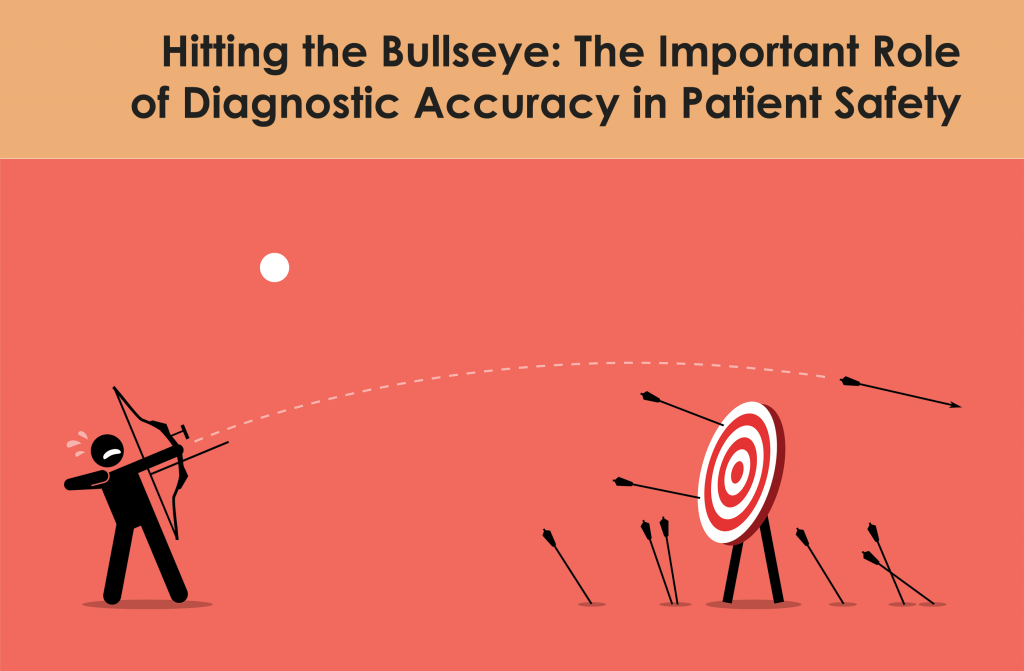The Safety Blog
The Safety Blog serves to highlight patient safety news and stories aimed at upholding our mission: safe care for every patient, every time, everywhere.
HITTING THE BULLSEYE: THE IMPORTANT ROLE OF DIAGNOSTIC ACCURACY IN PATIENT SAFETY
by Karen M. Markwith RN, MJ, CPHRM, CHPS | Director of Quality and Patient Safety, Virginia Mason
In our January 2018 strategic planning session, diagnostic error rose to the top of the discussion and became one of the two key areas we voted to devote WPSC efforts to this year, the other being patient safety culture. To that end, we’ve split our Action Planning Subcommittee into two groups: Diagnostic Error and Patient Safety Culture, in an effort to divide and conquer. Below, Karen Markwith of Virginia Mason, one of the members of the Diagnostic Error group chaired by Randy Moseley, explains the importance of diagnostic accuracy as it pertains to patient safety and why we’ve chosen it as a focus.
There are two decisions you need to make when first taking up archery: Which type of archery are you interested in, and which bow will work best for you? These two decisions will provide you with an increased chance of accuracy in hitting the target or bullseye. The goal of accurately diagnosing a patient’s condition is similar to an archer’s goal of hitting the bullseye.
The Institute of Medicine’s (IOM) committee’s definition of diagnostic error is as follows: The failure to (a) establish an accurate and timely explanation of the patient’s health problem(s) or (b) communicate that explanation to the patient (NAS).
Unfortunately the lack of an accurate diagnosis is more common than we realize and can result and serious harm; even death.
WHAT THE RESEARCH SAYS
Using varied methodologies, studies have found the following:
- Major diagnostic errors that may have contributed to the patient death have been detected in 10% of autopsies[1]
- In hospitals, an estimated 7%-17% of adverse events result from diagnostic errors, based on studies of retrospective record reviews[2]
- At least 1 in 20 adults experiences a diagnostic error each year, based on studies in U.S. outpatient settings[3]
- Inaccurate or delayed diagnoses can also have repercussions beyond a single episode of care and cause ripple effects in the form of inaccurate treatment plans, adverse health events, and psychological and financial consequences.
TARGETS TO AIM TOWARD
The IOM published a report in 2015 on diagnostic errors and the need to improve diagnosis.[4] According to the report, to improve diagnosis is a “moral, professional, and public health imperative.” The report identified eight overarching goals and many supporting recommendations. I am not going to go in-depth on each goal but provide some perspective on a few that could be considered reasonable suggestions.
Eight Goals Outlined in the IOM Report
- Teamwork among healthcare professionals, patients and families
- Education and training regarding the diagnostic process
- Supportive health IT systems
- Identification of errors and near misses and efforts to learn from and reduce them
- A supportive culture and work system
- Learning-focused reporting and medical liability systems
- Supportive payment and care delivery environments
- Research funding
STRENGTH IN NUMBERS
The focus on teamwork among healthcare professionals, patients and families and the improvement of communication is pivotal to improving accuracy in the diagnostic process. Communication among all members of the team must be timely and effective as well as clearly documented in the medical record, according to the IOM report. To improve teamwork, the breaking of silos and paradigms among members of the diagnostic team is also an innovative step in increasing accuracy. For example, integrating laboratory staff into assisting with what type of test should be run could assist a clinician when unsure of which tests are best suited to the clinical problem or how to interpret results. Contributions from other healthcare professionals can be value-added to improve the diagnostic process through their monitoring of the patient condition and the sharing of observations concerning the patient’s response to treatment.
ACCOUNTING FOR BIAS: THE WIND FACTOR OF DIAGNOSIS
Obtaining a variety of information also helps support the reduction of inherent bias, or what is often referred to as cognitive bias, that can contribute to an inaccurate diagnosis as well. Cognitive biases are a universal feature of human cognition like system errors for the brain. Understanding the contribution of cognitive bias and the interaction of bias with system errors and how they may produce bad outcomes should be part of the education and training regarding the improvement of accuracy in the diagnostic process. According to Graber et al (2015), when conceptualizing cognitive error whenever a patient is harmed in relation to the diagnostic process, two broad categories of causal factors should be considered:[5]
1) The “Blunt End” — All the system-related elements that contribute to diagnosis.
2) The “Sharp End” — All the cognitive factors.
Cognitive bias also can produce anchoring, which is the tendency to rely too heavily on the initial piece of information offered when making decisions. In this case, we risk starting from an initial impression and failing to adjust appropriately. The concept of anchoring when applied to the diagnostic process is the tendency to perceptually lock on salient features in the patient’s initial presentation too early in the diagnostic process, and fail to adjust this initial impression in light of later information.
Common “anchors” that can contribute to an inaccurate diagnosis:
- Billing codes
- Reason for consultation
- Problem lists
- Previous admissions
- Old diagnosis-new problem
- Previous provider notes
These are just a few examples of what could easily be a longer list. The key component is awareness of the concept of “anchoring” and ensuring that these cognitive biases do not contribute to a diagnostic error.
LEARNING FROM ERRORS AND NEAR MISSES
An example of the #4 goal — identification of errors and near misses and efforts to learn from and reduce them — is understanding the value of a near miss. Near misses are the best signal that something is not right and needs some dedicated attention before the error reaches the patient. One of the most latent near misses that needs a more rigors process is how a clinician addresses “missed labs” by the patient as well as lab results that are narrowly missing the high or low parameters of the diagnostic test. Paying attention to near misses and using them as “teaching moments” can help redesign work systems that support team member involved in the diagnostic process.
Just as the right tools for archery can increase the likelihood of reaching the target, the right goals can help clinicians increase their accuracy with patient diagnosis. As a patient, I want my healthcare professionals to hit the bullseye every time!
ABOUT THE AUTHOR
 Karen Markwith, RN, MJ, CPHRM, CHPS is the Director of Quality and Patient Safety at Virginia Mason Medical Center. Experience includes Regional Director of Enterprise Risk Management for a large health system with multi-state responsibilities. Director of Risk Services for a multi-hospital system and Director of Provider Services for a large medical group. Received graduate degree in Master of Jurisprudence in Health Law from Loyola Law School in Chicago and undergraduate degree in Bachelor of Science in Nursing from Pacific Lutheran University. Co-authored ASHRM 2016 Physician Office Risk Management Playbook as well as the 2017 Healthcare Risk Management Fundamentals manual.
Karen Markwith, RN, MJ, CPHRM, CHPS is the Director of Quality and Patient Safety at Virginia Mason Medical Center. Experience includes Regional Director of Enterprise Risk Management for a large health system with multi-state responsibilities. Director of Risk Services for a multi-hospital system and Director of Provider Services for a large medical group. Received graduate degree in Master of Jurisprudence in Health Law from Loyola Law School in Chicago and undergraduate degree in Bachelor of Science in Nursing from Pacific Lutheran University. Co-authored ASHRM 2016 Physician Office Risk Management Playbook as well as the 2017 Healthcare Risk Management Fundamentals manual.
WORKS CITED
[1] Shojania, K.G., Burton, E.C., McDonald, K.M. & Goldman, L. (2003). Changes in rates of autopsydetected diagnostic errors over time: A systematic review. JAMA, 289:2849-2856.
[2] Leape, L.L., Brennan, T.A. & Laird, N. (1991). The nature of adverse events in hospitalized patients. Results of the Harvard Medical Practice Study II. New England Journal of Medicine, 324, 377-84.
[3] Singh, H., Meyer, A., & Thomas, E. (2014). The frequency of diagnostic errors in outpatient care: estimations from three large observational studies involving US adult populations. BMJ Quality & Safety, 23(9), 727-731.
[4] National Academies of Sciences, Engineering, and Medicine. 2015. Improving diagnosis in health care. Washington, DC: The National Academies Press.
[5] Graber, M.L., Reilly, J.B., Trowbridge, R.L. (2015). How to do a root cause analysis of diagnostic error. Patient Safety Awareness Week webcast. National Patient Safety Foundation. https://pdfs.semanticscholar.org/presentation/d4f5/ad7772573a8a3e3d7d5e4808303ace42bf4d.pdf
THE IMPACT OF LANGUAGE & CULTURAL BARRIERS ON PATIENT SAFETY & HEALTH EQUITY
by Anita Sulaiman, Founding Consultant & Trainer
IBEX | Inter-Cultural Business Excellence
If you have ever been in a situation where you do not speak the language of the land and cannot understand or make yourself understood, you know what it is like to face a language barrier. Imagine needing medical attention in that environment.
In any given setting, the inability to effectively communicate can be very limiting and stressful. In a healthcare setting – where even in the happiest of circumstances like the birth of a newborn, people are feeling anxious and vulnerable – that stress is amplified and that limitation has significant repercussions on patient safety, health outcomes, and health equity.
A DIVERSE LANDSCAPE MEANS DIVERSE NEEDS
One out of five, or over 60 million people in the United States, speak a language other than English at home[1]. Forty-two percent of this group is Limited English Proficient (LEP)[2], meaning they speak English less than “very well.” This segment of the U.S. population is at risk for adverse events because of impediments associated with their language ability.
In Washington State, approximately 660,000 people are LEP[3]. Whatever the patient care setting, as this country becomes increasingly diverse, health systems are encountering more and more LEP patients and families from various different cultures. Language and cultural barriers present critical challenges to both providers and patients in ensuring meaningful access[4] to quality care. Recipients of government funding are mandated by a number of laws to provide language access to healthcare services. The reality is that many struggle to fulfill this obligation. Our healthcare system, in its current state, is not equipped to operate in an environment where a large section of the constituency requires language assistance.
LEP PATIENTS FACE BARRIERS TO ACCESS FROM STEP ONE
Unless you are a person with limited English proficiency, it is easy to forget how much of a barrier language and culture can pose. Simply scheduling an appointment can be an ordeal if you do not speak English. As part of a cultural competency audit I was conducting as a consultant on several hospitals in different states, I had to make telephone calls to these hospitals as if I was an LEP patient. On one, where I presented myself as a Chinese-speaker, this was what ensued:
Hospital employee answering the phone (in English): Good morning, _______ Medical Center. Can I help you?
“Patient”: Hello. I’d like to see a doctor please.
Hospital: Do you speak English?
“Patient”: I speak Chinese. I don’t speak English.
Hospital: Do – you – speak – English?
“Patient”: I’m telling you, I don’t speak English. My English is not good. Can you help me please?
Hospital: You need to speak English if you want to be in this country! [Click. Hangs up.]
This was some time ago and it is an extreme example, but non-English speakers continue to experience variations of this scenario in their encounters with medical facilities every day. Language barriers can preclude meaningful access. In egregious cases, while it is more the rarity than the norm, they face outright discrimination. To compound an already difficult situation, trust becomes an issue. Even when a facility’s staff members are trying their best, lack of training often impedes their ability to provide competent care. Seemingly innocuous actions like using ad hoc or untrained interpreters can and do result in patient harm.
UNADDRESSED LANGUAGE BARRIERS CAN HAVE DEVASTATING EFFECTS
Ineffective communication has been shown to lead to a host of problems. There is plenty of anecdotal and empirical evidence that language and cultural barriers jeopardize a system’s effectiveness and disadvantage people who do not speak or are not fluent speakers of English. Researchers from Boston Medical Center and Boston University School of Public Health found that individuals who do not speak English at home are less likely to receive colorectal cancer screenings than those who do. Their findings[5] demonstrate that language barriers contribute to health disparities. This has important implications. Colorectal cancer is the third most common cancer in the U.S. It is the second leading cause of cancer-related deaths in men, and third in women. Examples abound of medical errors with devastating effects resulting from failure to address these barriers. That is particularly unfortunate, because these are largely avoidable risks.
One of the most (in)famous is the case of 18-year old William Ramirez. He arrived at a South Florida hospital unconscious, after suddenly developing a splitting headache at a school event. Before collapsing, he told his girlfriend, who spoke limited English, “Me siento intoxicado”. When the ambulance arrived, she repeated “intoxicado” to the paramedics who, as minimal Spanish-speakers, misinterpreted it as “intoxicated”. They brought him to the emergency department, where he was treated for a drug overdose. Ramirez woke up paralyzed. Turns out he had a brain hemorrhage, which left him a quadriplegic for life. The bleeding was overlooked until too late. After being in a coma for 48 hours, doctors ordered a CT scan, which revealed that his head was flooded with blood. Apparently, feeling “intoxicado” can also mean “sick to the stomach”, which is a symptom of brain aneurysm. The miscommunication led to a $71 million malpractice lawsuit.
COMMUNICATION BREAKDOWNS CAN HAPPEN AT EVERY LEVEL – AND THEY CAN BE COSTLY
According to a 2015 CRICO Strategies Benchmarking Report, Malpractice Risks in Communication Failures[6], a third of national malpractice claims involve a communication failure. Mixed into that general description is miscommunication due to language barriers. Fifty-five percent of the 23,658 cases (filed from 2009 and 2013) analyzed reflect miscommunication between providers and patients. Twelve percent involve that, as well as breakdowns in communication between two or more healthcare providers, indicating that miscommunication between providers is a significant part of the problem.
These are healthcare quality issues and they can be costly. In the above report, there were 7,149 cases accounting for $1.7 billion of total incurred losses from irreparable patient harm due to communication failures. Reports and studies like this shine a light on risks to patient safety and, conversely, opportunities to mitigate those risks, prevent harm, reduce health disparities, and improve safety. They identify specific drivers of these breakdowns, offering organizations actionable data to guide and inform improvement initiatives, strategy formulation, and policy-making.
NTEGRITY OF COMMUNICATION IS A CRUCIAL KEY
Language is at the heart of communication and any exchange of information. When there is a breakdown, vital information that both patients and providers rely on is not captured, not delivered, not accurate, delayed, or just plain incorrect. There is a disconnect between the holder of the information and the person who needs it. That, in turn, can lead to errors, mismanagement, and injury. Where multiple providers are part of a care team, the systemic risk is inherent in every link in the entire chain. Integrity of communication is a crucial key to the system’s success. When that integrity is compromised, so is the system’s ability to provide safe and effective care.
- Safety issues related to language tend to be easier to recognize than those related to culture. Twice more hospitals reported identifying a direct relationship between patient safety issues and patients’ linguistic needs than cultural needs.
- Equal numbers from both groups reported identifying safety issues related to linguistic issues, but 17% more from the judgment group reported issues related to culture. Arguably, making a concerted effort makes a difference.
- One Northeast region hospital, by stratifying their adverse event data by language, found that there were clusters of adverse events in patients with English as a second language. This connection between language and safety highlighted for them the challenges of providing care to LEP persons.
- At another hospital, making accommodations around medication self-administration with their Navajo patients, who had varying degrees of English proficiency and health literacy, improved patient understanding and medication compliance.
- A Midwest region hospital improved their Emergency Department flow by increasing language services and working to better understand the community they serve.
It is clear that addressing language and cultural needs can directly impact safety, outcomes and health equity.
PROVIDERS HAVE A RESPONSIBILITY TO CROSS THE CHASM
Hospital administrators will tell you that the chasm that is language and cultural barriers is not an easy one to cross. But that chasm is also a quality and safety one. It is, therefore, imperative that providers seek to understand it and prioritize efforts to bridge it. As they work to heal and promote health, practitioners have a responsibility to pay particular attention to vulnerable populations and their special needs.
What makes bridging the chasm so challenging? There are many contributing factors. A national survey titled, Hospital Language Services For Patients With LEP[7], listed inability of staff to identify patients who need language services before they arrive at a hospital and cost and reimbursement concerns as the most cited barriers hospitals face in providing language services. Some other obstacles mentioned were lack of tools and training resources, lack of community-level data and staff discomfort with asking patients to provide information on their primary language.
My own experience administering a system-wide program charged with ensuring culturally and linguistically appropriate services, for what was then the largest provider in the Pacific Northwest, gave me valuable insights into many of the operational-level challenges that systems face in providing meaningful access to all populations. Issues include staffing, funding, changing demographics/language needs, interpreter quality and supply, availability of good, up-to-date data, organizational culture, organizational structure, policy and internal processes – each of which impacted our ability to deliver the desired quality throughout the care continuum.
The challenges are daunting, but the benefits of grasping and addressing them are compelling – not only from a mission, but also business standpoint. It makes good business sense to provide safe care – for every patient, every time, everywhere. This, incidentally, is the vision of the Washington Patient Safety Coalition.
WORTH RECOGNIZING: WE ARE ALL PATIENTS
I remember an interesting observation made at HealthPact’s inaugural workshop in 2010[8], where I was involved as a Consumer Representative, and that is: providers, so focused on and immersed in their professional roles, often overlook the fact that we are all patients. One participant, a Risk Manager, noted, “It’s amazing; how do we forget that? We don’t think that, at some point, we are all patients”. It should not be, but it was quite the discovery. You would think it is easy to put yourself in the patient’s shoes; it is not.
The idea to include patients in the important conversation around improving communication was a great one. The people for whom the medical industry exists in the first place have traditionally not been given a seat at the table. Your customers are always the best people to tell you what they need, as well as if and how well their needs are being met. This is a good one to keep in mind. The patient’s perspective is, more often than not, neglected. As many involved in quality improvement efforts are discovering, it can be the most valuable.
EQUAL ACCESS IS A RIGHT, NOT A PRIVILEGE
Lest we forget: Healthcare is a right; so is equal access to care. The words of Martine Pierre-Louis, Director of Interpreter Services at Harborview Medical Center, a stalwart of the cause, offer hope. She shared with me this nugget about her experience: “I have encountered politics, I have encountered bureaucracy, I have encountered things that make me angry. But in all my years of doing this work, I encounter, overwhelmingly, a sense of devotion, compassion and service.”
The goal of ensuring safe, quality care for all is not just commendable and lofty, it is necessary. People’s lives — our lives — and well-being depend on it.
ABOUT THE AUTHOR

Anita Sulaiman is Founding Consultant and Trainer at IBEX Consulting. Her extensive international experience and professional background span public and private sectors, for-profit and not-for-profit enterprises, in industries including aviation/aerospace, healthcare, electronics, retail, manufacturing, hospitality, military/defense and government.Her areas of expertise are communications, leadership development, cultural competency, language access, change management and business process re-engineering.
Ms. Sulaiman is passionate about helping individuals and organizations excel in a global world through executive and business coaching, technical consulting and cross-cultural training.Anita began her career as a management consultant, spearheading organizational transformation initiatives in multi-national corporations for Alexander Proudfoot and REL – global leaders in productivity, quality, and working capital management. This systems background enabled her to take the management of linguistic services at Swedish Medical Center to a new level. She has since helped various healthcare institutions in Washington and other states identify barriers to equal access and formulate strategies to better serve diverse communities.
Anita has continued to stay at the forefront of efforts to improve patient safety, serving on advisory groups and committees for organizations including the Washington Patient Safety Coalition, Foundation for Health Care Quality (Patient & Family Advisory Council) and Washington State Coalition for Language Access.Anita graduated with a Bachelor of Business in Business Administration from the Royal Melbourne Institute of Technology in Australia. She is fluent in Bahasa Indonesia and Malay; and speaks basic Mandarin (Chinese). Anita is happiest when her work involves building bridges – between people, cultures, organizations and countries.
[1] Source: U.S. Census Bureau, 2011 American Community Survey
[2] DOJ defines LEP individuals as individuals who do not speak English as their primary language and who have a limited ability to read, write, speak, or understand English. LEP individuals may be competent in English for certain types of communication (e.g., speaking or understanding), but still be LEP for other purposes (e.g. reading or writing).
[3] Source: Washington State Office of Financial Management: 2016 Estimates of Population With LEP
[4] DOJ defines meaningful access as language assistance that results in accurate, timely and effective communication at no cost to the LEP individual. For LEP individuals, meaningful access denotes access that is not significantly restricted, delayed or inferior as compared to programs or activities provided to English proficient individuals.
[5] A Linksky, N McIntosh, H Cabral, LE Kazis. Patient-Provider Language Concordance and Colorectal Screening. Journal of General Internal Medicine, 2010; DOI: 10.1007/s11606-010-1512-9
[6] 2015 Comparative Benchmarking System (CBS) Report. CRICO is a division of The Risk Management Foundation of the Harvard Medical Institutions Incorporated.
[7] 2006, by the Health Research & Educational Trust.
[8] HealthPact was started in 2010 as a statewide, multi-stakeholder collaborative created to promote transparency and communication in healthcare. In 2016, it was integrated into the Washington Patient Safety Coalition (WPSC).






